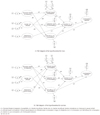Abstract
Purpose
The purpose of this study was to test and validate a model to predict contraception behavior in unmarried men and women.
Methods
Data were collected from a questionnaire survey of 180 unmarried men and 186 unmarried women 20 years of age or over who had sexual relationships in the past 6 months. Participants were from Seoul, Kyunggi, Daegu, and Busan and data collection was done from February 19 to April 16, 2013.
Results
Model fit indices for the hypotheoretical model fitted to the recommended levels. Out of 15 paths, 11 were statistically significant in both. Predictors of contraception behavior in unmarried men and women were intention to use contraception and self-efficacy for contraception. Exposure to sexual content was directly significant to the intention in men only. Self-efficacy for contraception was affected by perceived threat of pregnancy and gender role attitude. In women, the two predictors were also significant except for the effect of exposure to sexual contents.
Conclusion
Results indicate that an intervention program which increases self-efficacy in unmarried men and women contributes to effective contraception behavior. In addition, proper sexual education programs using positive aspect of mass media can help develop active participation for contraception behavior.
Figures and Tables
References
1. Kim HY, Sun BY, Kim EY, Jung JH. Report No.: Research Report-10. Unwed mother's life world and policy agenda. Seoul: Korean Women's Development Institute;2009.
2. Lee IS, Choi GY, Cha SH, Park HY, Lee JJ. A survey on the sexual behavior of adolescents in South Korea: The third survey in 2007. Korean J Obstet Gynecol. 2010; 53(6):512–519. http://dx.doi.org/10.5468/kjog.2010.53.6.512.
3. Sieving RE, McRee AL, McMorris BJ, Beckman KJ, Pettingell SL, Bearinger LH, et al. Prime time: Sexual health outcomes at 24 months for a clinic-linked intervention to prevent pregnancy risk behaviors. JAMA Pediatr. 2013; 167(4):333–340. http://dx.doi.org/10.1001/jamapediatrics.2013.1089.
4. Ajzen I. The theory of planned behavior. Organ Behav Hum Decis Process. 1991; 50(2):179–211. http://dx.doi.org/10.1016/0749-5978(91)90020-T.
5. Kang HS. An explanatory model of condom use among Korean college students [dissertation]. Seoul: Yonsei University;2001.
6. Kim MJ. A structural equation model explaining contraception behaviors of married Korean women [dissertation]. Seoul: Yonsei University;2001.
7. Fishbein M. A reasoned action approach to health promotion. Med Decis Making. 2008; 28(6):834–844. http://dx.doi.org/10.1177/0272989x08326092.
8. Song JE, Chae HJ. Knowledge and educational need about contraceptives according to sex in college students. Korean J Women Health Nurs. 2010; 16(4):399–408. http://dx.doi.org/10.4069/kjwhn.2010.16.4.399.
9. Witte K, Cameron KA, McKeon JK, Berkowitz JM. Predicting risk behaviors: Development and validation of a diagnostic scale. J Health Commun. 1996; 1(4):317–341. http://dx.doi.org/10.1080/108107396127988.
10. Hwang SW, Chung CW. Contraception behaviors in unmarried men and women: A descriptive qualitative approach. Perspect Nurs Sci. 2012; 9(2):71–82.
11. Moon YP. A study of sex-role attitudes, role-expectations and role-performances among urban married couples [master's thesis]. Seoul: Ewha Womans University;1989.
12. Peter J, Valkenburg PM. Adolescents' exposure to sexually explicit material on the internet. Communic Res. 2006; 33(2):178–204. http://dx.doi.org/10.1177/0093650205285369.
13. Choi MI. Determinants on the exposure to internet sexually explicit materials and adolescents' sexual attitudes. Korean J Journal Commun Stud. 2009; 53(2):49–69.
14. Yu JP. The concept and understanding of structural equation modeling. Seoul: Hannarae Publishing Co;2012.
15. Kang HS, Chang SB. Development of college students' condom attitude scale. J Korean Acad Nurs. 2004; 34(5):751–759.
16. Hwang SW, Chung CW. Contraception behavior and related factors in unmarried female and male. Korean J Women Health Nurs. 2011; 17(1):77–87. http://dx.doi.org/10.4069/kjwhn.2011.17.1.77.
17. Primack BA, Switzer GE, Dalton MA. Improving measurement of normative beliefs involving smoking among adolescents. Arch Pediatr Adolesc Med. 2007; 161(5):434–439. http://dx.doi.org/10.1001/archpedi.161.5.434.
18. Statistics Korea. Economically active population survey. Daejeon: Statistics Korea;2007.
19. Lee KH. Popular culture and sex education for teenager. Paper presented at: College of Nursing Seoul National University Seminar. 2013 April 17; College of Nursing Seoul National University Main Center. Seoul:
20. Kim EM, Yu SJ, Song MR. Correlation between history of exposure to obscene material, sexual attitudes and intercourse experience among university students. J Korean Acad Fundam Nurs. 2013; 20(1):18–26.
21. HwangSong MH, Kim JM, Moon I. Predicting adolescent sexual behaviors and attitudes from the use of harmful media. J Korean Soc Sch Health Educ. 2008; 9(2):1–13.
22. Do M, Fu H. Is women's self-efficacy in negotiating sexual decision-making associated with condom use in marital relationships in Vietnam? Stud Fam Plann. 2011; 42(4):273–282.




 PDF
PDF ePub
ePub Citation
Citation Print
Print





 XML Download
XML Download